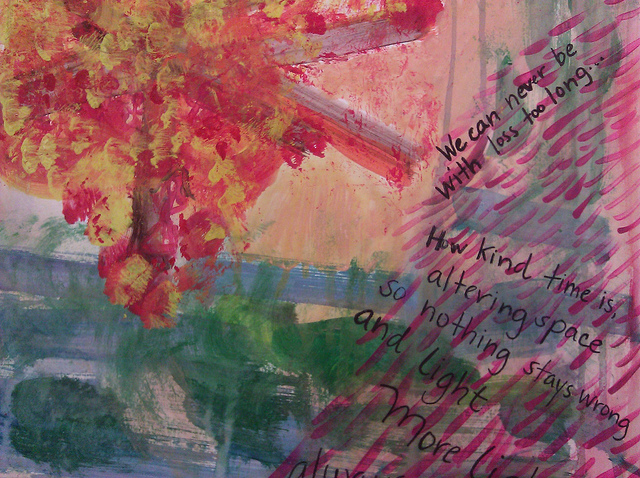
Abuse, whether emotional or physical, is a hard pill to swallow. It impacts our body, heart and spirit tremendously and healing is an arduous (and often unpleasant) process.
Yet, in many yoga or spiritual traditions, I have heard again and again that when it comes to abuse I was supposed to forgive my abusers, whether it was for myself or for the sake of harmony.
I tried and I simply failed.
I didn’t feel compassion for the people who abused me. I felt anger.
I began discussing the issues with the shamans who have been following me and did some soul searching of my own. Here are a few steps on the path to healing:
- Yes, it is your abuser’s fault…
Ana Forrest, an international yoga teacher who has spoken openly about abuse, actually advises to start your healing process by assigning the blame to your abuser. I believe this is an essential and powerful step.
The shame and horrendous aftermath of physical or emotional abuse has nothing to do with you. It was brought onto you by another person, and you have full right to blame them for it. I am not saying that wallowing on past events or spending your life plotting revenge is the way to go, it is, however, wise to apply one of Ruiz’s Four Agreements: take nothing personally.
Your abuse happened to you, but not because of you; it has to do with your abuser dealing with whatever dark matter was boiling in their veins. It doesn’t make you more spiritual to belittle the impact this experience and this person had on you.
Facing head on how traumatic the abuse was is essential.
- But healing is on you…
This can be a hard thing to hear, but the reality is that no one else but you can be in charge of your healing process. Though you were not responsible for your abuse, you are fully responsible for healing.
This can be incredibly difficult: Since you were not responsible for what happened, why are you the one left dealing with the horrible consequences? You are entitled to this feeling, but it is quite useless dwelling on it. Here is another way to look at it: You have the power to heal, and that’s something no abuser can take away from you.
An important step on this journey is asking for help, in whatever form that suits you most. During the yoga workshop I mentioned, I spent the whole morning with a terribly heavy weight in my chest after talking about sexual assault and I felt powerless dealing with it alone. At lunch break, I sat down with a group of people playing hang drum and Tibetan bowls (leaving on the side the fact that social interactions and asking for help scare the crap out of me) and a few minutes later I was laying on my back with instruments on my chest and eight people offering me the gift of reiki. I bawled my eyes out for hours after that, but I reached a level of inner peace I had never felt since before what happened to me.
You are in charge of finding the people or resources that will help you transcend your abuse. Connect with healers, may it be friends, yoga teachers or professional therapists. There is no doubt that physical abuse keeps on living in the body—traditional or alternative forms of therapy can all help.
- Dive and release.
Abuse so often lives in a dark corner of our brain where we want to shove it forever. I truly believe that to heal, we need to connect with the whole scope of the abuse and the wounds it has left in us. This, in turn, allows us to deal with shame and hopefully let go of harmful behaviors we may have developed as a result of the abuse.
I realized that I wasn’t on a journey to release my abusers just for the sake of doing it. I was just so tired of being angry and hateful—and, boy was I angry. While receiving reiki, I kept telling one of my abusers in my head: “I release you” over and over again, and it felt so freeing.
In a way, my abuser was living in my body and I just wasn’t interested in carrying him anymore.
- Check your environment and history.
Talking about abuse with an African American folk healer, she reminded me that many of us live in environments that are filled with multigenerational trauma, which means we are (consciously or not) part of cycles of abuse, fear and secrecy.
“Many survivors are asked to acknowledge their abuse within their living families and, if appropriate, forgive people who abused them and any family members who perpetrated the abuse. This process is for the survivors—it’s not so important how their family reacts though it’s helpful to receive support. Acknowledgement and forgiveness serve as kind of release rituals which freeze the generational cycle.” ~ Richael Faithful
Apart from forgiving perpetrators, which might be possible or not, you might be in the position to help the healing of other survivors. Survivors who speak can also become truth tellers in their communities, which breaks the cycle of denial and silence that breeds abuse.
After this realization, I have decided to be more aware of how the history of my family, direct and past, might impact me, including the fact that my ancestors have been Creole slaves, persecuted Jews and war victims.
- Be in your body
Being present in your body after experiencing abuse can be anywhere from uncomfortable to downright horrifying. However, it is a crucial step. Whether you have experienced physical or emotional trauma, it does live in your body. Also, being centered physically will always help you on your path to healing.
You don’t have to do handstands or put your legs behind your head! Something as basic as turning inward and taking deep breaths is the one of the best things you can do for yourself. Simply be watchful: How do you feel? Close your eyes and breathe deeply. Focus on the issue that needs healing. Does it live in a particular area of your body? Are your shoulders or eye muscles tight? Can you feel your pelvic floor?
Breathe into whatever area(s) call for it. Chanting is also an amazing way to make energy move through the body? Feel emotionally weighted down? Excel chanting “ah.” Feel it in your heart. There are many meditations with chanting out there, so find one you like (although it’s better to be instructed by a qualified teacher)! You can also use visualization: When I feel overwhelmed during energy work sessions I visualize the (younger) person I was before or during the abuse and sends love and compassion to her. It can be as simple as imagining myself hugging her. The bottom line is: This young woman I was, was doing her best and didn’t deserve what happened to her. Loving her helps me love and forgive myself today.
Whatever you decide to do about your own trauma, cleaning the areas where it lives will most surely include crying, shaking and going through intense physical and emotional sensations. Welcome this intensity—you are going into the depth of your wounds. You are hunting your fears for the sake of your own healing.
Forgiveness, at the end of the day, isn’t much about your abuser at all. It is about facing your trauma and realizing that, no matter what, you have the potential to be happy and free of shame or remorse. In releasing our abusers, we release the sense that we are powerless victims.
For me, I truly started my healing process when I realized it wasn’t about my abuser. My abuse was in the past and, with all my heart, and all the love I could give myself, I realized I simply didn’t want to carry it in my present anymore.
Always remember that you have a birth right to heal. This is your life, your journey. As Rupi Kaur said so well, this is “the hurting, the loving, the breaking, the healing.”
You are not forgiving your abusers because they deserve it.
You are releasing them because you deserve to be free.
To learn more about healing intergenerational trauma and the power of survivors, head over this article with Richael Faithful.
~
Author: Soizic June Hagege
Editor: Travis May
Image: Flickr/Julie Jordan Scott






Read 0 comments and reply